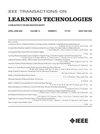Augmentation of Learning Content With Knowledge Components: Automatic Unit Labeling for Various Forms of Japanese Math Materials
IF 4.9
3区 教育学
Q2 COMPUTER SCIENCE, INTERDISCIPLINARY APPLICATIONS
引用次数: 0
Abstract
As the use of learning contents on educational platforms increases, it is desirable to augmentation these contents with unit information representing skills and knowledge in accordance with the curriculum. However, in many cases, there is a heavy burden placed on domain matter experts to manually label the unit information to such contents. Against this background, the demand for automatic labeling of unit information to learning contents is increasing. In previous research, classification using以知识成分扩充学习内容:多种形式日语数学教材的自动单元标注
随着学习内容在教育平台上使用的增加,需要根据课程来增加这些内容,增加代表技能和知识的单元信息。然而,在许多情况下,领域问题专家手动将单元信息标记到这些内容上是一个沉重的负担。在此背景下,对单元信息自动标注学习内容的需求日益增加。在以往的研究中,使用n-gram和随机森林的分类在自动单元标记方面取得了很高的性能。由于该方法分析的是内容文本中的常用词,因此仅在同质学习内容中发现了这些结果。在本研究中,我们进行了一项实验,以寻找可用于标记各种形式的文本数学学习内容中的单元信息的最佳方法。实验结果表明,使用二元图作为矢量化方法的感知器方法对所有预测数据集的组合都表现良好。即使在只有少量不同类型的学习内容可用的情况下,我们提出的方法在标记内容时也优于其他方法。该系统的实施可以从内容的角度分析学生的行为,帮助教师高效地组织上传的单元资料,帮助学生识别相关内容进行针对性复习。
本文章由计算机程序翻译,如有差异,请以英文原文为准。
求助全文
约1分钟内获得全文
求助全文
来源期刊

IEEE Transactions on Learning Technologies
COMPUTER SCIENCE, INTERDISCIPLINARY APPLICATIONS-
CiteScore
7.50
自引率
5.40%
发文量
82
审稿时长
>12 weeks
期刊介绍:
The IEEE Transactions on Learning Technologies covers all advances in learning technologies and their applications, including but not limited to the following topics: innovative online learning systems; intelligent tutors; educational games; simulation systems for education and training; collaborative learning tools; learning with mobile devices; wearable devices and interfaces for learning; personalized and adaptive learning systems; tools for formative and summative assessment; tools for learning analytics and educational data mining; ontologies for learning systems; standards and web services that support learning; authoring tools for learning materials; computer support for peer tutoring; learning via computer-mediated inquiry, field, and lab work; social learning techniques; social networks and infrastructures for learning and knowledge sharing; and creation and management of learning objects.
 求助内容:
求助内容: 应助结果提醒方式:
应助结果提醒方式:


